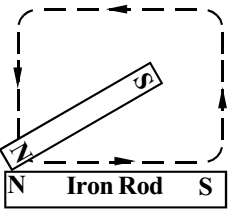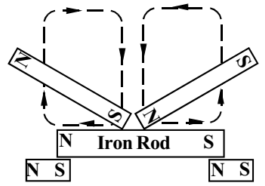Science > Physics > Magnetism > Magnetization and Demagnetization
In this article, we shall study the methods of magnetization, methods of demagnetization and Induced Magnetization. The process of converting iron or its alloys into a magnet is called magnetization.
Methods of Magnetization:
Single Touch Method:

Keep the bar which is to be magnetized on a wooden table. Take a strong permanent magnet and bring one of its poles (say north pole) to one end of the rod and gently rub the magnet on the rod from one end to the other. When the other end is reached, lift away the magnet from the rod and bring back to the starting end. Repeat the process several times.
The rod will get magnetized such that its starting end will act as the north pole and the other end as the south pole. If the south pole of the magnet is used for magnetization, then the rod will get magnetized such that its starting end will act as the south pole and the other end as the north pole.
Divided Touch Method:

Keep the bar which is to be magnetized on a top of two permanent magnets. Take another two strong permanent magnets and bring their opposite poles and touch them in the middle of the rod and gently rub the two magnets on the rod moving away from each other towards the end. When ends are reached lift away the magnets and bring back them again at the starting position. Repeat the process several times.
The rod will get magnetized such that the end where the south pole leaves the rod becomes north pole and the end where the north pole leaves the rod becomes south pole. The use of supporting magnets increases the strength of magnetization.
Double Touch Method:

Keep the bar which is to be magnetized on a top of two permanent magnets. Two permanent magnets separated by a piece of wood or cork are held together such that their opposite poles are together. This combination is placed on the rod at the centre and then moved to and fro without lifting it. The rod gets magnetized such that the opposite pole that to the nearest stroking magnet is created on its ends. The use of supporting magnets increases the strength of magnetization.
Electrical Method:

Wound an insulated copper wire around the rod forming a coil. Pass a strong direct electric current through the coil for some time. The rod gets magnetized. Such magnets are called electromagnets, The end of the rod at which current enters in anticlockwise direction becomes north pole and the other end of the rod becomes south pole.
Methods of Demagnetization:
The process used to destroy the magnetic properties of the material is called demagnetization. Demagnetization can be done
- by rough handling of the magnet.
- by continuously dropping it from a height or by hammering.
- by heating the magnet to high temperature and allowing it to cool, by keeping it in the east-west direction. This breaks the orderly alignment of molecules of the magnet.
- passing high frequency alternating electric current. This breaks the orderly alignment of molecules of the magnet.
- A single magnet left on its own loses magnetism due to induction between molecules.
- When a magnet is kept near another magnet of similar strength with their like poles facing each other, both get demagnetized due to induction in a few days.
Induced Magnetism:
When a permanent magnet is brought near a magnetic material like iron without touching it, the iron rod behaves like a magnet and attracts iron filings, clips towards itself. When the magnet is removed, the iron rod loses its magnetic property and the attracted iron filings and clips fall down. Thus magnetic material (iron rod) behaves like a magnet so long it is kept near the magnet.

The magnetism acquired by a magnetic material when it is kept near a magnet is called induced magnetism. The process in which a piece of magnetic material acquires the magnetic properties temporarily due to the presence of another magnet near it is called magnetic induction.
If we consider north pole of inducer magnet, then the end of the rod near to the north pole becomes south pole and the far end of the rod becomes north pole. Thus magnetic pole induces an opposite polarity on the near end and similar polarity on the farther end of the iron rod.
Characteristics of Induced Magnetism:
- Induced magnetism has no independent existence.
- Induced magnetism is temporary.
- Inducer magnetic pole induces an opposite polarity on the near end and similar polarity on the farther end of the iron rod.
- Induced magnetism precedes attraction.
Factors Affecting Magnetic Induction:
- The strength of the inducing magnet. More powerful magnets can produce a high induced magnetism in magnetic substance.
- Magnetic induction is inversely proportional to the distance between the inducing magnet and magnetic substance.
- It depends on the nature of the magnetic substance.
Notes:
- Induced magnetism in soft iron is temporary. Hence it is used for making temporary magnets.
- Induced magnetism in steel is permanent. Hence it is used for making permanent magnets.
- The degree of magnetization is steel is less than that in soft iron.
- Steel retains magnetic properties for a long time because its retentivity is high.
- soft iron retains magnetic properties for a short time because its retentivity is weak.
Induced magnetism precedes attraction:
When a permanent magnet is brought near a magnetic material like iron without touching it, the iron rod behaves like a magnet. Inducer magnetic pole induces an opposite polarity on the near end and similar polarity on the farther end of the iron rod. If we consider north pole of inducer magnet, then the end of the rod near to the north pole becomes south pole and the far end of the rod becomes north pole. Thus the pole of inducer magnet and pole produce on the rod are unlike, hence they attract each other. Thus induced magnetism precedes attraction.
Induced magnetism has no independent existence:
When a permanent magnet is brought near a magnetic material like iron rod without touching it, the iron rod behaves like a magnet. When the magnet is removed magnetism in the iron rod disappears. Thus the existence of induced magnetism in the rod is associated with the presence of an inducer magnet. Thus Induced magnetism has no independent existence.
Induced magnetism is temporary:
When a permanent magnet is brought near a magnetic material like iron rod without touching it, the iron rod behaves like a magnet. When the magnet is removed magnetism in the iron rod disappears. Thus the existence of induced magnetism in the rod is associated with the presence of an inducer magnet. Thus induced magnetism is temporary.
Experiment to Show That Induced Magnetism is Temporary:
Bring anyone pole of a bar magnet near small iron nails. A chain of nails gets formed. Because magnetism is induced in one of the nails near to the pole and it acts as a magnet and attracts remaining nails towards it. When the magnet is moved away (removed). The induced magnetism is lost and all the nails fall down. This shows that the induced magnetic is temporary.
Previous Topic: Properties of Magnet
Next Topic: Magnetic Field and Magnetic Lines of Force